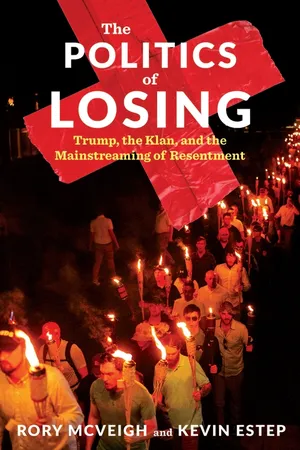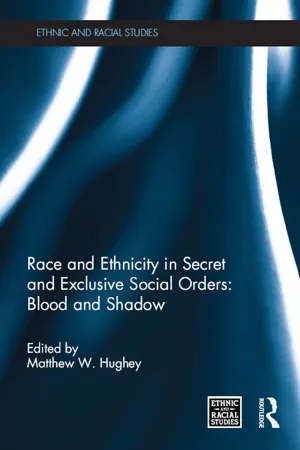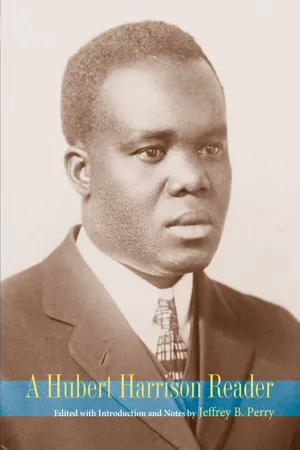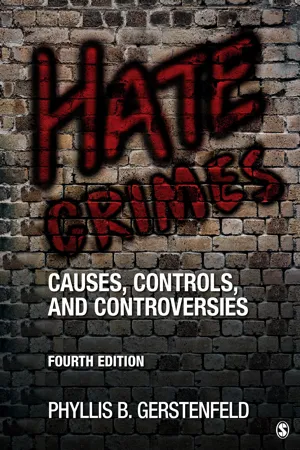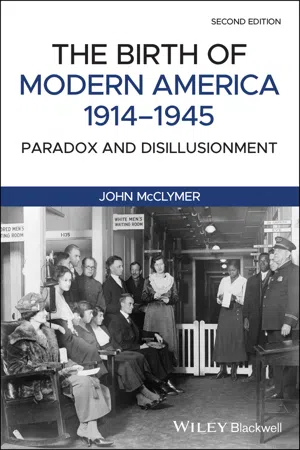History
Ku Klux Klan
The Ku Klux Klan (KKK) is a white supremacist organization that was founded in the United States in 1865. The group has a long history of violence and intimidation against African Americans, as well as other minority groups. Despite being outlawed at various times throughout its history, the KKK continues to exist in various forms today.
Written by Perlego with AI-assistance
Related key terms
Related key terms
1 of 4
Related key terms
1 of 3
12 Key excerpts on "Ku Klux Klan"
- eBook - ePub
Right-Wing Women
From Conservatives to Extremists Around the World
- Paola Bacchetta, Margaret Power(Authors)
- 2013(Publication Date)
- Routledge(Publisher)
At each period of Klan activism, a number of discrete and often antagonistic Klan groups have claimed to be descendants of the original Klan. Although each Klan is distinct in its leadership and membership, the groups are unified in an agenda of hatred toward African Americans and members of other racial, religious, ethnic, and now, sexual minority groups. They also use similar organizational names, clothing, and rituals. The four most significant waves of Klan activity occurred in the 1860s, 1920s, 1970s, and from 1980 to the present (Bennett 1988 ; Chalmers 1981). The initial Klan arose in the mid-1860s, at the end of the Civil War. Born as a violent response by southern whites against efforts at racial and political realignment within the U.S. South during Reconstruction, the first wave of the Klan loosely linked gangs of impoverished rural white male southerners, wealthy plantation owners, and industrialists who feared the loss of their political and economic supremacy. Women did not participate as members in this initial Klan, although white southern women were evoked as symbols of the tradition of racial and sexual supremacy that Klan men were expected to protect. This wave of the Klan was intensely violent, fomenting a bloody sweep of lynchings, assaults, arsons, and destruction and expropriation of property across the former states of the Confederacy, directed at freed African-American slaves, northern representatives of the Reconstruction government, and whites thought to be sympathetic to the new racial order - eBook - ePub
- Tore Bjørgo, Miroslav Mareš, Tore Bjørgo, Miroslav Mareš(Authors)
- 2019(Publication Date)
- Routledge(Publisher)
2Ku Klux Klan
Vigilantism against blacks, immigrants and other minorities
Kathleen Blee and Mehr LatifThe Ku Klux Klan (KKK or Klan) is the most enduring form of vigilantism in United States history, extending from the 1870s through to today. The Klan is not historically continuous, despite the Klan’s claims to the contrary in an effort to project an image of power and constancy (Blee, 2012). In fact, the Klan has appeared and then disappeared several times throughout U.S. history with different targets for its vigilante violence. Moreover, although the Klan presents itself as a unitary organization, in every Klan era there are separate and competing Klan groups and leaders. All Klan groups, however, are consistent in their efforts to organize vigilante violence and threats against racial, ethnic, religious, and national minority groups and non-white immigrants to the United States. Jews and those whose ancestry can be traced to the nations of Africa and Latin America, whether they are native-born or immigrants, are the most historically constant enemies of the Klan. Catholics, Mormons, Muslims, and those whose ancestry can be traced to the nations of Asia have also been the victims of Klan vigilantism in most eras, as have, at various times, labor union organizers, gay men, lesbians, and other sexual minorities, and employees and supporters of the federal (national) government.To understand the Klan’s agenda of fomenting vigilantism against particular groups of people, it is important to view each era of the KKK within the particular social, political, and economic context in which it arose and mobilized supporters and, upon occasion, voters. Four distinct eras witnessed significant mobilization by Ku Klux Klans in the United States: the 1870s, immediately after the Civil War over slavery; the interwar 1920s, which was characterized by high rates of immigration from Europe; the 1950s–1960s, which witnessed legal and political challenges to racial segregation or racially exclusive voting practices in the southern states; and the 1980s–2000s, during which the Klan allied with other far-right racist groups to forge a Pan-Aryan alliance. We discuss each era of the Klan within its historical context to explain how it justified and gained popular support for vigilante agendas and practices, which we define as actions or serious threats of extra-legal violence that replace or enhance the legitimated violence of the state such as the police, courts, and military. We pay attention to the wider context in which the Klan developed, how it was organized, its principle vigilante activities and strategies, and its relationship to electoral and government actors. In particular, we focus on how the Klan’s use of violence was shaped by its relationship with the state. - eBook - ePub
The Politics of Losing
Trump, the Klan, and the Mainstreaming of Resentment
- Rory McVeigh, Kevin Estep(Authors)
- 2019(Publication Date)
- Columbia University Press(Publisher)
By comparing Trump’s rise with that of the Klan we do not mean to equate the two, or exaggerate the extremism of Trump or the people who voted for him. Each time the Klan erupted, it attracted huge followings, drawing in members and supporters who were, in many ways, quite ordinary. On a Saturday night, a Klansman might light a cross and march down Main Street in full hooded regalia. And on Sunday morning he might go to church and picnic with his family in the afternoon. Our comparisons help us explore when and how white nationalist movements emerge, but also how their goals enter the mainstream. We look at the Klan of the 1920s because it was the most effective in attracting broad support, spreading farther and faster than the others. Its growth surprised its contemporaries and still puzzles us today. Understanding it will crack the code of Trump’s own surprising rise to power. But first, we revisit all the Klans of the past.THE RECONSTRUCTION KLANThe first Ku Klux Klan emerged as Southerners dealt with the devastation of the Civil War. Historians estimate that six hundred thousand Americans died in the war, which also destroyed the South’s transportation infrastructure, property, and local economy.1 The Southern elite, in particular, faced the challenge of rebuilding their fortunes—fortunes made through property ownership and slave labor.2 They worried about the economic consequences of emancipation, and feared violent retribution from former slaves and, worse, a coming political revolution that could seize their land.3 Before the Klan came into being, white Southerners already anticipated black threats to institutional white supremacy—and reacted with violence.4This violence was itself an extension of practices developed before the war, when “night riders” patrolled the countryside to capture escaped slaves and intimidate those who might be contemplating escape.5 Slaves were geographically concentrated. A relatively small proportion of Southerners owned the vast majority of slaves, who worked primarily in cotton-growing regions of the Deep South. To ward off rebellion, slave owners would sometimes don white sheets, pretending to be ghosts, in an effort to scare slaves into submission.6 Folklorist Gladys-Marie Fry writes that whites in the South were terrified of the prospects of slave uprisings: “Slaves posed a constant threat, a storm cloud that could erupt at any moment into a hurricane of disaster.”7In 1865, in Pulaski, Tennessee, six Confederate war veterans founded the Ku Klux Klan. It’s not clear how they came up with the name. Two of the original members would later claim that it was meaningless but sounded mysterious.8 These first Klansmen were relatively prosperous and styled themselves as intellectuals: Frank McCord was the editor of the local newspaper; Calvin Jones, John Lester, and Richard Reed were attorneys; James Crowe was a cotton broker; and John Kennedy, it appears, was a well-off farmer, though not a plantation owner.9 Historical accounts say that the men started the group, at first, to relieve boredom. They staged plays and concerts in Pulaski:10 McCord played the fiddle, and Jones played the guitar.11 Some evidence suggests that they were part of the minstrel tradition, performing locally under the name of the “Midnight Rangers.”12 - eBook - ePub
Steel Valley Klan
The Ku Klux Klan in Ohio's Mahoning Valley
- William D. Jenkins(Author)
- 2014(Publication Date)
- The Kent State University Press(Publisher)
By November 1923, however, the Klan had changed Warnock’s mind. He became not only a member but eventually a grand titan (district official). Warnock and many other local residents had assumed that the Klan would duplicate the violent and disruptive activities of the earlier organization. Gradually they came to view the Klan as a protector, rather than a violator, of the moral and legal order, an organization worthy of northern Protestant Christians’ support. In their minds the Klan of Reconstruction was dead. A new Klan had arisen.The Klan of Reconstruction had sought the control of race relations in the South after the Civil War. The granting of political rights to freed blacks posed a threat to white supremacy and might lead, the Klan feared, to social equality. The beatings, whippings, tar and featherings, and lynchings used to intimidate blacks politically and socially eventually caused the federal government to outlaw the Klan in 1871. Members then joined similar organizations, such as the Knights of the White Camelia. By the 1890s the North had grown weary of intervention, thereby permitting southern states to pass laws disfranchising blacks and segregating them from white society.Refounded in 1915 by Colonel William J. Simmons, the new Ku Klux Klan also emphasized white supremacy but differed from the earlier Klan in its emphases on fraternalism, nativism, and moralism. After failing as a clergyman and salesman, Simmons had found some professional success as a district organizer for the Woodmen of the World, one of the many fraternal societies joined by Americans of that era. Realizing the popularity of a secret society with elaborate rituals and passwords, Simmons fashioned a Klan that would appeal to the fraternal sentiments of American society—a Klan with acronyms functioning as a secret language, strange-sounding titles like kleagle, grand goblin, and imperial wizard, and a system of rituals known only to members. Simmons’s charter, obtained from the state of Georgia, described the organization as a “patriotic, military, benevolent, ritualistic, social and fraternal order.” Once a month local meetings, complemented by family picnics and parades, created a sense of camaraderie that appealed to native-born, white, Anglo-Saxon, Protestant men.2 - eBook - ePub
Race and Ethnicity in Secret and Exclusive Social Orders
Blood and Shadow
- Matthew W. Hughey(Author)
- 2015(Publication Date)
- Routledge(Publisher)
The 1920s Ku Klux Klan was the most successful far-right movement in United States history, at least in terms of its power to elect political candidates, recruit dues-paying members, and rally supporters. Over the course of a decade, several million white native-born Protestants joined the male Ku Klux Klan and as many as a million enlisted in women’s Klans (Chalmers 1981; Blee 1991; MacLean 1995; Lay 2003; McVeigh 2009). Although the original post-Civil War Klan was largely confined to the rural South, the second wave of the Klan also sank root in the cities, small towns, and rural areas of the North. Its agenda was both nationally-unified and locally-specific. All Klan chapters proclaimed a vicious message of racism, anti-Catholicism, and anti-Semitism, but many targeted local enemies as well, such as Mormons and labour radicals. Their efforts to achieve white, Protestant supremacy were multifaceted, ranging from the ballot box to violence and intimidation. The Klan’s tactics also included a series of orchestrated rumour campaigns, such as stories that a Catholic Pope was travelling in disguise to plot the take-over of the US government and that Jewish merchants were selling contaminated food.From the perspective of the twenty-first century, the 1920s Klan’s vicious attacks on African Americans, Jews, Catholics, and others seem extraordinary and politically extreme. In its historical context, however, the Klan’s ideas and organization were fairly unremarkable. Its racial and religious bigotry was more explicit and overtly tied to tactics of brutality and terrorism against its enemies than was common in the political discourse among many white Protestants. Yet, the Klan’s underlying belief in white and Christian supremacy and its racially-exclusive definition of ‘Americanism’ was held by many white Protestants who were never official members (Ehrenhaus and Owen 2004).The Klan’s associational structure mirrored the secret and fraternal orders in which many people participated in the 1920s, including its pyramid scheme of dues collection that proved especially lucrative for its leaders. Like other fraternal societies, the Klan drew on the metaphor of brotherhood as it asked members to pledge themselves to each other and the larger Klan family. Leaders proclaimed fraternalism as one of the six essential qualities of the Klan, along with associated attributes of being benevolent, ritualistic, social, patriotic, and militaristic. Even the Klan’s racialized expression of brotherhood was unremarkable among its fraternal contemporaries. Its exclusivity was more vitriolic, but not all that different from other white and Protestant-dominated voluntary and fraternal associations at the time (Cohen 1989; Ngai 1999; Gotham 2000; Camp and Kent 2004). Indeed, the Klan’s resemblance to other voluntary associations – its ordinariness – partly accounts for its ability to mobilize vast numbers of women and men. - eBook - ePub
- Henry P. (Henry Peck) Fry(Author)
- 2010(Publication Date)
- Perlego(Publisher)
A careful investigation of the history of the original movement shows that it was divided into three separate and distinct periods. It was first organized as a secret society for the amusement of its members, without any serious attempt to act as a “regulator” of social and political affairs; it was then transformed into a great political-military movement, enforced law and order, drove the negro and the carpetbagger out of politics, and was then ordered disbanded; and lastly it attempted in unorganized fashion, without the authority of its former leaders, to rule many communities, and an enormous number of acts of violence were committed either by it or in its name.There were several different organizations which sprang into existence in the South during the reconstruction periods, each one operating along the same general lines but bearing different names. There were the Ku Klux Klan, the White Brotherhood, the Pale Faces, the Constitutional Union Guards, and the Knights of the White Camelia, which was larger than any of them. In the latter days of the reconstruction, when acts of lawlessness in the South were so bad that an investigation was held by Congress, the general name of Ku Klux was applied to all extra-legal Southern movements. As this narrative deals only with the Ku Klux Klan, a discussion of the other movements is unnecessary.The Ku Klux Klan was organized in Pulaski, Tenn., in May, 1866. Several young men who had served in the Confederate Army, having returned to their homes, found themselves suffering from the inactivity and reaction that followed army life. There was nothing to do in which to relieve it. There was but little work to do, and but few had capital to engage in new mercantile or professional pursuits. The amusements and diversions of normal society were lacking, and to meet this situation, it was decided to form a secret society merely for the purpose of burlesque and fun-making. After the society was organized, and a name was sought, one of the members suggested the word “kukloi” from the Greek word “Kuklos - eBook - ePub
- Annie Cooper Burton(Author)
- 2012(Publication Date)
- Perlego(Publisher)
The very name Ku Klux shows that the order was formed among men of letters. It is a Greek word meaning circle. Klan suggested itself; the name complete in turn suggested mystery. Originally the order was purely a social organization, formed in Pulaski, Tennessee, May, 1866, and gave diversion to the restless young men after the reaction of war. They found vast amusement in belonging to a club which excited and baffled curiosity; great sport, too, was found in initiating new members. But it was when the Klan realized that it had a great, vital work to perform that it rose majestically to the gigantic task.When the order at the end of a year had grown throughout the South to such a size that a master hand was needed to guide it, Nathan Bedford Forrest, famous cavalry general of the Southern Army, he of the charmed life, a man who was in "more than one hundred battles and had twenty-seven horses shot under him," a leader famous for his military strategy, was elected Grand Wizard of the Invisible Empire. Forrest always stressed the order that no fighting would be allowed. If they needed to fight they would throw off their disguise and fight like soldiers. Their purpose was to scare into submission the unruly free negroes and the trouble-making carpetbaggers; and this purpose they accomplished, without one drop of blood being shed, except in the most extreme cases. Whenever an undesirable citizen was not wanted, he generally found a note tacked to his door saying that if he did not move on within twenty-four hours he would be visited by the Ku Klux Klan. Signed "K. K. K." The man generally "moved on" long before the stipulated time.The negroes, being naturally superstitious and imaginative, helped the order to gain power. In Nashville, Tennessee, among the five dens, there was one formed of medical students from the University. One of the favorite pranks of these young doctors was to ask a negro to hold their horse, and then place in his hand as he reached out to take the lines a finger or a hand taken from a corpse. The negro generally went a mile before he stopped running. Another effective trick practiced by the Klan was, when they had a negro on trial, to sprinkle beforehand a little powder on the floor—"hell fire," they called it—and when the negro would be looking down at the floor one of the Klansmen would surreptitiously run his foot over the powder line, and a fiery-looking trail would show. The negro would be paralyzed with fright, and was always careful in the future never to have cause to be brought before the Order again. - Susan R. Burgess, Kathryn C. Leeman(Authors)
- 2016(Publication Date)
- CQ Press(Publisher)
Chapter 5 ), and to the passage of the 1964 Civil Rights Act, which banned racial segregation in public accommodations, restricted discriminatory hiring and housing practices, and empowered the federal government to bring lawsuits and revoke funding of public school systems that failed to integrate. United Klans of America members were implicated in some of this violence, including the July 11, 1964, murder of Lt. Col. Lemuel Penn, a Black World War II veteran who was fatally shot while driving through Clarke County, Mississippi, on his way home from Army Reserve training.In the wake of this dramatic upsurge in Klan violence, President Lyndon B. Johnson and Attorney General Robert Kennedy pressured FBI director J. Edgar Hoover to take a more active role in restoring order in the South. Prior to this time, Hoover had viewed the civil rights movement’s civil disobedience and purported ties to communism as a greater threat to national security than the Klan, generally considering the investigation and prevention of White supremacist violence as a state law enforcement issue (see Chapter 5 ).134 However, in September 1964, Hoover established a secret program that came to be known as COINTELPRO–White Hate, an offshoot of an earlier secret FBI counterintelligence program called COINTELPRO, established in 1956 to target communist groups operating within the United States (see Chapter 2 ). Although the FBI increasingly assisted local law enforcement in the investigation of Klan crimes, the bureau was less interested in obtaining convictions in court than in disrupting and discrediting the Klan, both internally and externally. In a memo to agents regarding the establishment of this counterintelligence program, the director of the FBI’s Domestic Intelligence Division wrote, “We intend to expose to public scrutiny the devious maneuvers and duplicity of the hate groups; to frustrate any efforts or plans they may have to consolidate their forces; to discourage their recruitment of new or youthful adherents; and to disrupt or eliminate their efforts to circumvent or violate the law.”135- eBook - ePub
The Unseen Power
Public Relations: A History
- Scott M. Cutlip(Author)
- 2013(Publication Date)
- Routledge(Publisher)
Constitution’s one-time owner. His partner and sometimes bedmate was Elizabeth Tyler, an uneducated country girl but a woman of shrewd instincts. They formed their partnership in 1917 to promote wartime fund-raising drives. By 1920, their business had pretty well petered out.First a bit of background on the Klan’s earlier history: The original Ku Klux Klan was formed in the wake of the Civil War in Pulaski, Tennessee, by six bored and restless Civil War veterans. More than 125 years later, it stands as perhaps the most mysterious and certainly the most feared fraternal organization in American history. In its early stages, the organization’s purpose was “to make mischief and play pranks,” but it quickly got out of hand. Confederate General Nathan Bedford Forrest, though not one of the organizers, became the Klan’s Imperial Wizard in 1867. By this time, the Klan had become a group that found great sport in hazing and harassing African Americans. Under Forrest’s leadership, the Klan grew in numbers and in ruthlessness. By the spring of 1868, the Klan was fully launched throughout Tennessee as a vigilante group.Subsequently the Klan left such a trail of terrorism, lynchings, and hysteria that President Ulysses S. Grant ordered its elimination from American society. Grant, a much-criticized President, took a more aggressive stand against the night-riding Klan than any other President before or after him until President John F. Kennedy. The terrorizing of both White and African-American citizens who incurred the wrath of a Klansman caused President Grant to dispatch the Seventh U.S. Cavalry to South Carolina to eliminate the Klan there. (The Seventh Calvary was so successful in its mission that it was then dispatched to quell the Indians at Little Big Horn under General Custer. That mission was not successful!) In response to President Grant’s action, General Forrest ordered the original Klan disbanded early in 1869. However, it took an Act of Congress and the recovery of power by Southern White leaders before the original Klan disappeared into the dustbin of history. - eBook - ePub
- Hubert Harrison, Jeffrey B Perry, Jeffrey B Perry(Authors)
- 2021(Publication Date)
- Wesleyan University Press(Publisher)
To come straight to the point. Speaking of that earlier band of bloody brothers, the World says: Nobody familiar with reconstruction legislation will deny that there was justification for the Klan’s political activities, although its methods in innumerable cases were brutal, criminal and indefensible. Its practices of intimidation were uniformly cowardly, and it was tolerated by decent Southerners only because they were living under an autocratic government imposed upon them by Federal bayonets and were ready to use any weapon on which they could lay their hands.…The Ku Klux Klan of Reconstruction days even at its worst represented an organized resistance to political oppression only. We do not argue that this view is either unjust or dishonest, we merely insist that it isn’t true. The facts are recorded in that very report of the Congressional Committee of Investigation to which the World makes reference, but which we sadly conclude that it has never read. We do not wonder at this for the collection of ponderous tomes dealing with the different States is indeed a formidable thing to tackle. However, there are other records in print which are easier of access. We name the following at random: James G. Blaine’s Twenty Years of Congress, volume 2; William Garrott Brown’s The Lower South in the Civil War ; Alexander Johnson’s article in Labor’s Cyclopedia of American History ; Carl Schurz’s Report; the series of articles in The Nation in 1865 and 1866 contributed by its then editor, Edwin Lawrence Godkind, and the third volume of Prof. Albert Bushnell Hart’s American History Told by Contemporaries. A perusal of these volumes will show that the Ku Klux Klan was organized in 1865 (the date is very important), during the interregnum between the dastardly murder of Abraham Lincoln and the convening of Congress which took place in December of that year - eBook - ePub
Hate Crimes
Causes, Controls, and Controversies
- Phyllis B. Gerstenfeld(Author)
- 2017(Publication Date)
- SAGE Publications, Inc(Publisher)
Copyright 1996, The University Press of Kentucky. Reprinted with permission of The University of Kentucky Press. Hate Group Ideologies The previous section serves as an introduction to only a few of the major hate groups. In reality, these groups exist in a bewildering variety, with many permutations and combinations. Individual groups frequently squabble over specific beliefs, practices, and tactics; indeed, these squabbles frequently result in the genesis of new groups because disgruntled members desert an established group to form their own. There are, however, certain basic principles that constitute the core ideology of almost all hate groups. Power The first of these principles and, arguably, the most important, is power. White supremacist groups, which constitute the majority of hate groups, are concerned with whites (especially white men) losing their traditional control over others. Other hate groups are usually dedicated to gaining some of that power, generally at the expense of other groups. Interestingly, the theme of power is rarely overtly discussed within hate group literature and propaganda. It does, however, form the rallying cry for the white supremacist movement: “White power!” And its importance is strongly implied both by the circumstances that have led to hate group formation and by the indirect messages those groups convey. As we discussed in the previous section, hate groups are created, and membership increases, when the dominant group feels that there is a threat to its dominance. In the Reconstruction era, Southern whites founded the Ku Klux Klan when the slaves were freed and when blacks began to exercise independent political and economic authority. When Reconstruction ended and that authority was once again denied to blacks, the Klan disbanded. It reemerged around the time of the First World War and again during the civil rights era, both times when there were realistic threats to white domination - eBook - ePub
The Birth of Modern America, 1914 - 1945
Paradox and Disillusionment
- John McClymer(Author)
- 2021(Publication Date)
- Wiley-Blackwell(Publisher)
Comparisons of the first and second Klans yield a great many differences as well. The first Klan sought to put newly freed blacks back in “their place,” i.e., to restore white supremacy. The second, while also hostile to African Americans who tried to live as first‐class citizens, defined “white supremacy” to mean the ascendancy of “Nordic Americans” over all others. The members of the first Klan were overwhelmingly Protestant, but anti‐Catholicism formed no part of their movement. Nor did anti‐Semitism. Nor did nativism. The first Klan fixated entirely upon the immediate issues of Reconstruction. Moreover, while local klaverns of the second Klan did engage in “night riding” and other forms of vigilante activity, this was not the sole focus of the KKK of the 1920s. In fact, Imperial Wizard Evans and other Klan leaders sought, at least publicly, to distance the organization from the “invisible government” actions of the immediate postwar years and to insist upon the Klan’s reverence for established legal authority. The first Klan, in short, was a paramilitary organization; the second was not. Still another important difference is the second Klan’s insistence upon “Americanism.” The first was an organization of white Southern males. The second attracted support from all sections and from women.Some in the 1920s suggested a different historical comparison, the Know Nothing movement of the 1850s. Writing in the North American Review of January 1924, William Starr Myers noted that the Klan, “with the possible exception of masks, robes, and other like paraphernalia,…is an almost complete replica of the old Know Nothing movement of the ‘fifties of the last century.”The Know Nothing party…spread over the eastern and northern sections of the country, with Grand Councils, Superior Councils, Subordinate Councils, and all the other hierarchy of a well thought out and clear cut organization. It had a grip, pass words, secret signs, and much of the ritual that has proved so attractive to the average American citizen, whether the object of an organization be fraternal, social, political, or religious. It was organized in opposition to the naturalization of foreign immigrants, then first coming to the United States in large numbers, and also opposed to the activities and spread of the Roman Catholic Church.Unlike the Klan, the Know Nothings, aka the Native American Party, were not necessarily hostile to African Americans. In fact, in states like Massachusetts, the Know Nothings vehemently denounced the Kansas‐Nebraska Act and the Fugitive Slave Law. In Worcester, a center of Know Nothingism, the party swept the 1854 municipal elections as its newspaper, the Daily Evening Journal
Index pages curate the most relevant extracts from our library of academic textbooks. They’ve been created using an in-house natural language model (NLM), each adding context and meaning to key research topics.
Explore more topic indexes
Explore more topic indexes
1 of 6
Explore more topic indexes
1 of 4


